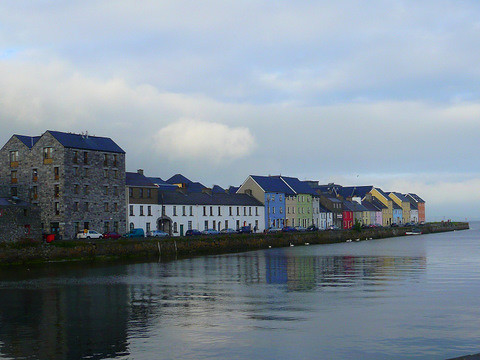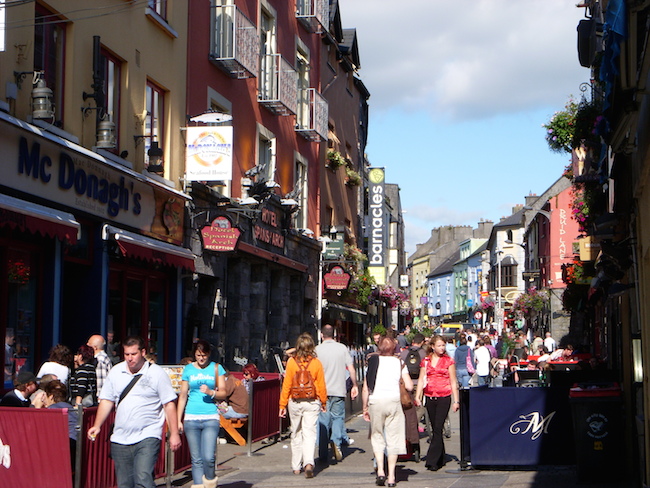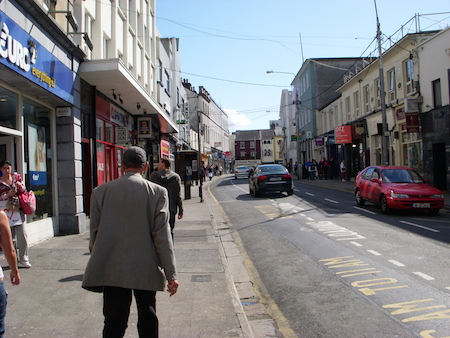
I recently went to Galway, Ireland, which was my first time out of North America. I had a ton of fun, and I also learned lots and lots. This is the first in a series of posts where I will try to share some of what I’ve learned.
As usual, a disclaimer: Nothing that I say should be taken as representative of American urbanists, or residents of Seattle, or residents of/visitors to Ireland. I speak only for myself, and any errors in fact or analysis are my own.
I believe that Galway is a shining example of how urbanist principles can lead to vibrant, delightful places, even with a surprisingly small population. My overarching thesis is that we must heed these lessons–which have been the foundation of city design for millenia–if we want Seattle to truly succeed as a city.
Scale
Every road in Galway is smaller than the corresponding road in Seattle. To give you a sense of scale, Google Maps reports traffic data for all regional roads in Galway, the vast majority of which have a single travel lane in each direction. A regional road is approximately comparable to a principal arterial in Seattle; that is, a route that isn’t part of the national/state roadway system, but that is considered to be a vital part of the regional transportation network. The typical principal arterial in Seattle has a minimum of two motor vehicle lanes in each direction, and many of those roads have 5 motor vehicle lanes (2+1+2) or 6 (3+3).
Within the city center, many roads are so narrow that they are one-way for motor vehicles by necessity: there simply isn’t enough room for two motor vehicle lanes. And a good portion of the roads within the boundaries of the old medieval city have been fully pedestrianized. There will occasionally be a motorcycle or emergency vehicle that drives through (access is via retractable bollards), but this happens extremely rarely. Note that the roads that have been pedestrianized are not necessarily the narrowest roads. The hotel that I stayed on was on a particularly narrow street; the pedestrianized Shop Street was easily twice as wide from end to end.
Streets are shorter and more closely spaced, and so block sizes are much smaller. Standing at any point in the city, you only have to walk a very short distance to have a choice about which way to turn. There are few “alleys” in the American sense; every block has a contiguous facade of buildings. But the effect is similar, since the average gap between two streets in Galway is smaller than the average gap between any pair of streets/alleys in Seattle.
Galway has none of the giant impermeable facades that are popping up throughout Seattle. I didn’t see a single building that took up an entire city block. There are a few indoor shopping complexes, similar to the ones in downtown (e.g. Westlake/Pacific Place). However, rather than taking up an entire block facade, the shopping center is cleverly placed behind existing buildings. You access the shopping center by walking to the end of a “dead-end” street. But the shopping complexes have so many access and interconnection points that they feel like an indoor extension of the city. I saw several other smaller examples of this principle, where a large store would have an L-shaped building, allowing the store to have a large interior footprint (and two entrances), but taking up a very small amount of street frontage.
Even the stores themselves are smaller, though also more numerous. Within the city center–and remember, this is a city with a total population of about 75,000, in a county with 250,000 people total–there were several department stores, including two Dunnes Stores; at least a dozen pharmacies/chemists; at least a dozen jewelry shops; at least three book shops; and so many restaurants and cafes and bars that I lost count. Each department store was quite small; maybe about the size of one floor of Nordstrom downtown. The pharmacies were smaller than an average Seattle 2BR apartment, and some were about the size of a studio. Imagine Walgreens opening three stores within the U-District, each of which was less than 1/4 of the size of their normal stores! And yet, all of them seemed to be doing great business. I personally patronized at least three different pharmacies in one day, just because I would go to whichever one happened to be closest when I needed to get something.
 All of this smallness means that walking is the default mode of transport in Galway city. People drive (or bike, or ride) to the city, but they walk in the city. Every neighborhood that’s considered to be part of the city is easily walkable from the city center. The distance that separates the U-District from downtown is greater than the distance that separates Galway from Renmore, a suburb that is distinctly not in Galway city.
All of this smallness means that walking is the default mode of transport in Galway city. People drive (or bike, or ride) to the city, but they walk in the city. Every neighborhood that’s considered to be part of the city is easily walkable from the city center. The distance that separates the U-District from downtown is greater than the distance that separates Galway from Renmore, a suburb that is distinctly not in Galway city.
Visually, Galway looks more like a Seattle neighborhood than like downtown. The tallest building in Galway (not counting church steeples) is probably about 20 meters high; the average building is just 2 or 3 stories. And yet, in practice, Galway functions much more like downtown. Galway is self-contained in a way that most Seattle neighborhoods are not. You can buy groceries at specialty shops in the city center, or supermarkets that are a 10 minute walk away. You can buy clothes, home goods, gifts, etc. without having to make a “pilgrimage” to somewhere like Northgate or Southcenter.
Street Design
The best streets in Galway are in the pedestrian zones. They’re lined with shops, and filled with people all day long. Everyone I talked to loved the pedestrian zones, and hoped that the city would expand them further.
Among non-pedestrianized streets, Galway has a surprising number that are one-way for motor vehicles by necessity. There isn’t enough room for two motor vehicle lanes, even with zero car parking and with sidewalks that are barely wide enough for one person. Unsurprisingly, cars drive slowly on these narrow, winding streets, since it wouldn’t be safe for them to drive quickly. Pedestrians will often walk along the edge of the street (off the sidewalk), especially when passing others. In addition, these streets are very easy to cross, and people do in fact cross them all over the place, rather than just at intersections (as US law theoretically requires). Finally, intersections between these streets are often unsignaled, like intersections between two minor residential streets in a Seattle neighborhood; the assumption is that cars will be moving slowly enough that complex traffic management isn’t necessary.
The wider streets in the city center generally have one traffic lane in each direction. Many local residents told me that they see these streets as having heavy traffic and being difficult to cross, but from an American standpoint, they struck me as being surprisingly quiet for “arterials”. I saw lots of people crossing these streets at all sorts of places, without relying on traffic control, and without needing to run. There are a handful of pedestrian crossing lights, but these do not necessarily occur at intersections; many of them are intentionally placed mid-block, at places with better visibility and where there are fewer conflicts between cars and pedestrians. (A pedestrian at a mid-block crossing only needs to look for cars coming from two directions; a pedestrian at a 4-way intersection faces a much more complicated problem.)
 An interesting property of Galway’s street network–which is actually shared by most “old world” cities–is that 3-way intersections are very common, while 5-way and greater intersections are almost unheard of. The reason for this is simple: streets are allowed to intersect anywhere, and so if there are three streets in close vicinity, chances are that they will happen to cross at different points. In contrast, with a grid system, almost all of your intersections are 4-way, and any “grid-incorrect” streets are almost guaranteed to eventually run into one of the normal grid 4-way intersections, creating a 5-way or 6-way. I believe that 5-way (and greater) intersections are particularly hostile to pedestrians for many reasons, and so it’s interesting to note that grid systems are inferior to organic street networks in this way.
An interesting property of Galway’s street network–which is actually shared by most “old world” cities–is that 3-way intersections are very common, while 5-way and greater intersections are almost unheard of. The reason for this is simple: streets are allowed to intersect anywhere, and so if there are three streets in close vicinity, chances are that they will happen to cross at different points. In contrast, with a grid system, almost all of your intersections are 4-way, and any “grid-incorrect” streets are almost guaranteed to eventually run into one of the normal grid 4-way intersections, creating a 5-way or 6-way. I believe that 5-way (and greater) intersections are particularly hostile to pedestrians for many reasons, and so it’s interesting to note that grid systems are inferior to organic street networks in this way.
(Thinking about it some more, I think the intersection problem is inherent to any system in which most streets are long. By long, I mean that streets are expected to continue through an intersection, rather than being allowed to fork or curve or terminate. Galway has tons of intersections where three streets intersect at nearly 120 degree intervals. If these streets continued through the intersection, then these 3-ways would become 6-ways. But they don’t.)
Outside the city center, roads become a bit wider. Depending on the importance of the road, they may have 1 or 2 motor vehicle lanes in each direction (where one lane in each direction may be reserved for buses), plus a small shoulder. My understanding is that there is a small section of motorway outside of Dublin that has 3 or even 4 motor vehicle lanes in each direction, but 2 is the most common number. Either way, you’d be hard-pressed to find a road the width of Aurora or 15th NW, let alone I-5.
Interestingly, roundabouts are everywhere, but they’re not used in the way that I had expected. The typical roundabout is an intersection between several national or regional roads in a rural location. It’s large, but fully at-grade, and very cheap to build and maintain. There’s no need for electricity or communications (as there would be with traffic signals), and they’re much simpler than any type of grade-separated junction. Basically, almost anywhere that an American traffic engineer would use some type of flyover junction for a road that isn’t an interstate highway, Ireland uses roundabouts. In my (limited) experience, they work brilliantly; they minimize delay for the common case (no congestion), and still continue to function with moderate levels of traffic.
On the other hand, closer to the city, roundabouts are more problematic. They’re not optimal at handling high volumes of traffic, and because of the lack of signals, it’s not possible to use synchronization or transit signal priority (TSP) to improve efficiency. Galway is actually looking into signalizing some of the roundabouts that are on certain key corridors (or maybe even replacing the roundabouts altogether), largely for the sake of introducing TSP. In the past, I’ve advocated for installing roundabouts at certain difficult Seattle intersections, but I’m no longer so sure.
Parking
Parking a car in Galway is not something to be undertaken lightly. Within the pedestrian zones, of course, there is no car parking. Many roads just don’t have enough room to accommodate parked cars. Conversely, the “wider” streets–the regional roads–generally eschewed parking in favor of additional sidewalk width and motor vehicle lanes.
There are a handful of car parking lots and garages on the fringes of the pedestrian area, as well as some cheaper ones further out. The impression I got was that most people parked their cars using one of these facilities, and then walked to their ultimate destination. As far as I can tell, the American phenomenon of trying to find a spot as close as possible to your final destination is pretty much unheard of. Everyone just assumes that they’ll park where they can, and walk (pleasantly!) to their destination.
American street car parking culture also has another negative externality. If someone is going to a restaurant in Seattle, and they manage to park right in front of the restaurant, then their evening itinerary will probably look something like “car -> restaurant -> car”. They’re not really going into the city; they’re just going to one particular place, and ignoring the rest of it. In Galway, the streets are filled with people who are simply on their way to somewhere else (or on their way back from somewhere). Because they’re not in cars, they get to enjoy the city along the way; they can stop and listen to buskers, or look in jewelry windows, or anything else.
Transit
Galway’s local bus service is pretty skeletal. There are about 12 diferent city lines, some of which are radial (i.e. city <-> suburb), and some of which are “cross-city” (i.e. suburb <-> city <-> suburb). The most frequent line runs every 15 minutes for most of the day; the other lines run every 20, 30, or even 45 minutes. There are also some commuter lines, which make a few inbound AM and outbound PM trips–often as few as one.
Ironically, the best transit is actually regional/national. Galway is connected to the national rail network, which (by American standards) is extremely comprehensive. There are trains that head south (to Limerick, with connections further south), and east (to Dublin), with many stops in between. There are also intercity buses that run between Galway and many other important destinations that are not directly served by rail.
From talking with friends, the impression I got was that the intercity transit services have a very high mode share, whereas the local services (at least outside of Dublin) have a harder time competing with cars. I think that this is a combination of tolls, high fuel prices/taxes, and the cost/difficulty of parking in Dublin.
Closing thoughts
In some ways, Galway feels very similar to Seattle. Both cities are proud to be weird. I saw just as much funky-colored hair in Galway (proportionally speaking) as I’m used to seeing in Seattle. But in another important way, they’re very different. Galway has an urban energy and vitality that can be difficult to find in Seattle. In Seattle, I’ve met quite a few people who still seem to think that we’re a small town or a suburb; a place where cars are the only acceptable method of transportation, and detached single-family homes are the only acceptable place to live. Despite its much smaller size, everyone I met in Galway seemed to understand that it was actually an urban place; their only complaints were that the economy wasn’t growing fast enough.
Is Galway’s attitude a byproduct of its historical geography? Or is it the other way around? Or are they both symptoms of a common cause? I don’t know. But either way, Galway shows that you can have an active, vibrant city that looks absolutely nothing like Manhattan. As Seattle moves into the next phase of its history, we should keep these lessons in mind.
Aleksandra (Aleks) is a software engineer who moonlights as a writer and copy editor. Aleks's love of cities started as a child, when she would ride the commuter rail into Boston with her family for day trips. Her mission is to share that love with the world, by ensuring that our cities have a place for everyone. Aleks primarily writes about transportation and land use. She is also the webmaster.



